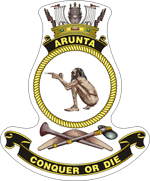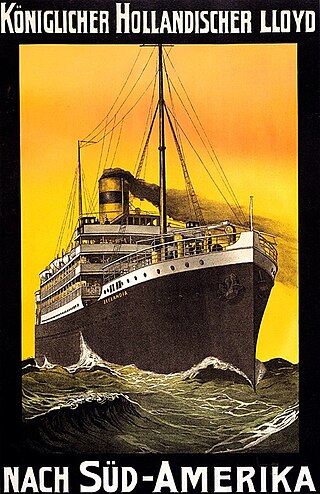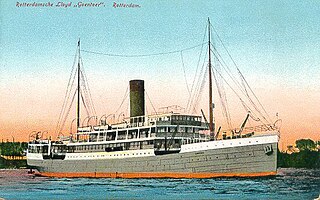Holland America Line is a US-owned cruise line, a subsidiary of Carnival Corporation & plc headquartered in Seattle, Washington, United States.

HMAS Arunta (I30/D5/D130) was a Tribal-class destroyer of the Royal Australian Navy (RAN). Named for the Arrernte Aboriginal peoples, the destroyer was laid down in 1939 and commissioned into the RAN in 1942.

Koninklijke Paketvaart-Maatschappij, was a Dutch shipping line in the Dutch East Indies, now Indonesia. It traded form 1888 to 1966. It was the dominant inter-island shipping line in the Dutch East Indies in the last half-century of the colonial era.

SS 's Jacob was a passenger steamship that was launched in the Netherlands in 1907 and sunk by enemy action off New Guinea in 1943. She spent most of her career with Koninklijke Paketvaart-Maatschappij, based in the Dutch East Indies.

Operation Lilliput was the name given to a convoy operation directed by G.H.Q. Operations Instructions Number 21 of 20 October 1942 for transportation of troops, weapons, and supplies in a regular transport service between Milne Bay and Oro Bay, New Guinea between 18 December 1942 and June 1943 in order "to cover reinforcement, supply, and development of the Buna-Gona area upon its anticipated capture" by the Australian 7th Division and the United States Army's 32d Division. Within six months, the convoys, escorted by Royal Australian Navy corvettes and largely composed of Dutch KPM merchant ships, had delivered 60,000 tons of supplies and 3,802 troops from Milne Bay to Oro Bay. Corvettes provided the majority of the escort force. Losses during Imperial Japanese air attacks amounted to two merchant ships, 's Jacob and Van Heemskerk, sunk and two badly damaged while several of the corvettes also sustained damage and casualties.

USS Zeelandia was an ocean liner that was built in Scotland in 1910 and scrapped in the Netherlands in 1936. She was the largest ship in the Koninklijke Hollandsche Lloyd (KHL) fleet from 1910 until the liners Gelria and Tubantia were completed in 1913 and 1914. She was USS Zeelandia from April 1918 until October 1919, when she was a United States Navy troopship.

USS Rondo (ID-2488) was a Dutch cargo steamship that was built for Stoomvaart Mattschappij Nederland in 1914. She served in the United States Navy from March 1918 until June 1919. She was scrapped in 1933.

USS Oosterdijk was a Holland America Line cargo steamship that was built in 1913 and sank as a result of a collision in 1918. She served in the United States Navy, with the Naval Registry Identification Number ID–2586, from March 1918 until her loss that July. Some sources anglicise her name as Oosterdyk, but Lloyd's Register registered her with the Dutch spelling Oosterdijk.
SS Binnendijk was a Holland America Line (NASM) cargo steamship. She was one of NASM's "B" class ships: the company's first cargo ships to be powered by steam turbines. Binnendijk was built in South Holland in 1921, and sunk by a mine in the English Channel in 1939. She was the first ship that NASM lost in the Second World War. Her wreck off the coast of Dorset, England is now a wreck diving site, nicknamed "The Benny".
SS Maasdam was a Dutch turbine steamship that was launched in 1920 and sunk in 1941. She was the third Holland America Line ship to be named after the village of Maasdam in South Holland.

SS Karsik was a German-built cargo steamship. Deutsche Schiff- und Maschinenbau (Deschimag) built her as Soneck for Deutsche Dampfschifffahrts-Gesellschaft "Hansa" in 1938.

SS Japara was a freighter of 3,323 GRT built by Mach. Fabr. & Scheepswerf P. Smit Jr., Rotterdam in 1930 and operated by Koninklijke Paketvaart-Maatschappij (KPM) in the Dutch East Indies trade. The 1930 Japara was operating with the United States Army permanent local fleet of the U.S. Army Forces in Australia (USAFIA) from 1942 until 1945 even while the larger ship, 9,312 GRT MS Japara (1938), was active in Army service oceanwide. Japara of 1930 played an important logistics role in the New Guinea Campaign.
SS Ajax was a cargo steamship that was built in Germany in 1923 as Elbe. In 1927 she was renamed twice, first to Ceuta and then to Ajax.

SS Op Ten Noort was a passenger steamship that was launched in the Netherlands in 1927. She was built for the Koninklijke Paketvaart-Maatschappij, who operated her in the Dutch East Indies. Op Ten Noort means "Up North".

MS Van Heutsz was a Dutch diesel powered passenger and cargo vessel of the Koninklijke Paketvaart-Maatschappij (KPM) line operating from Batavia in the Dutch East Indies. The ship, as was sister ship Cremer, was designed for the longer routes of the East Indies inter-island trade extending to Singapore and Hong Kong. The ships had limited cabin accommodation for passengers but large deck passenger capacity. Much of the passenger trade was with Chinese moving between China, Singapore and the East Indies.

Royal Rotterdam Lloyd was a Dutch shipping line that was established in Rotterdam in 1883 as Rotterdamsche Lloyd (RL). It became "Royal Rotterdam Lloyd" in 1947. RL mainly operated scheduled passenger and mail services between Rotterdam and the Dutch East Indies. Its independent existence ended in 1970, when KRL merged with four other Dutch shipping companies to form the Nederlandsche Scheepvaart Unie (NSU). In 1977 NSU became Nedlloyd.
SS Beemsterdijk was a Holland America Line (NASM) cargo steamship. She was one of NASM's B-class ships: the company's first cargo ships to be powered by steam turbines. She was built in Rotterdam in 1922.

SS Aquileia was a Dutch-built steamship that was launched in 1913 as the ocean liner and mail ship Prins der Nederlanden for Netherland Line. She ran scheduled services between Amsterdam and the Dutch East Indies until 1930, when she was laid up.

SS Goentoer was a Dutch passenger and mail ship that was built for Rotterdamsche Lloyd in 1902 and scrapped in 1925. Her regular route was between Rotterdam and the Dutch East Indies. She was a UK troop ship from 1918 to 1919, after being seized under angary in Singapore.

SS Van Waerwijck was a passenger steamship that was launched in the Netherlands in 1909 and sunk in the Strait of Malacca in 1944. She spent most of her career with Koninklijke Paketvaart-Maatschappij, based in the Dutch East Indies.


















